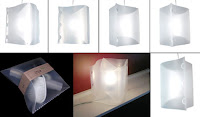
Korean museum patrons are getting another look at the latest in Japanese innovation in Universal Design. Seoul's Hangaram Design Museum hosts this year's exhibit.
Design Shows Way to Comfort
By Park Chung-a
The Korea Times
``Universal Design is not yet a familiar concept to the public. However, a handful of people are beginning to understand the new idea, which is aimed at creating environments usable for people of all different abilities, be they children, the elderly, men, women, disabled or pregnant women
If you cannot grasp the idea, try looking around the Hangaram Design Museum at Seoul Arts Center will give you a clue to understanding of this humanitarian concept. The museum displays works of universal design until Oct. 3, following the last years exhibition under the same theme.
The exhibition not only presents images of Korean cities that went through changes of spaces and design environment but also presents the best examples of universal designs both inside and outside of Korea. Some of the examples are reproduced in the exhibition so that the visitors can experience for themselves the convenience that they offer.
Some of the examples are Japan�s Miho Museum which has no ledge on the front door so that it can be accessed by people in wheel chairs, the public rest room of Fukuoka�s Canal City which has toilet stools and washstands of different heights for the use of children. Stairs have a slope in the center so that old people, bicycle-users and people dragging their baggage can use the stairs together is also part of universal design.
``In the case of Korea, the aging of society is becoming an urgent issue, which makes universal design even more necessary, said Lee Yeun-sook, a Housing and Interior Design Professor from Yonsei University. ``Although Korean people seem to be aware of the problem, efforts at applying universal design to their living environment are insufficient.
Satoshi Nakagawa, one of Japans most renown universal design experts and a representative of Tripod Design participated in organizing the exhibition. He said that while last year�s exhibition focused on teaching the concept of universal design, this exhibition has focused on showing how it can actually be applied to the urban environment.
Nakagawa said that universal design would naturally flourish in a society where respect and sincere care for others is prevalent.
``One of the reasons why Japan could become the world leader in the universal design industry is that it has a tradition of cherishing the value of community and respecting the elderly, rather than the valuing individualism. Although such a tradition has been weakened these days, I still think many Asian countries maintain such attitudes and I think it is the same here in Korea, Nakagawa said.
According to Nakagawa, universal design evolved from a desire to solve fundamental problems of design and its power has been discovered and reinforced since consumers started to participate in the process of making products.
``Before, lots of companies would just focus on mass-production. They would just unilaterally make products and sell them to people. However, since the 21st century, production became more and more user-oriented. Nowadays, the most important issue for producers is how to get close to consumers, he said. ``Thus, products began to be made in cooperation with consumers, and from there universal design naturally developed.
Nakagawa says universal design is aimed at filling the various desires of users by providing products in as many varied forms as possible. It is different from the concept of ``barrier-free products and equipment, which are just for a limited number of people and for specific situations.
``Universal design is for everyone�s comfortable use. It should enable anyone at anytime to use products and equipment without difficulties, he said.
Source:http://times.hankooki.com/lpage/culture/200509/kt2005090920123511690.htm Posted by rollingrains at September 11, 2005 04:29 PM
 Size : W920 X H2,000(mm)
Size : W920 X H2,000(mm) 















































